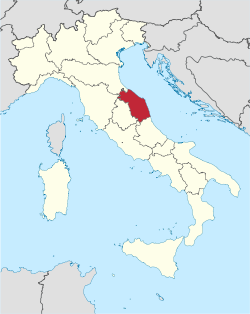Region of Marche
| Marche | |||
|---|---|---|---|
| Region of Italy | |||
|
|||
| Anthem: Inno delle Marche | |||
 |
|||
| Country | Italy | ||
| Capital | Ancona | ||
| Government | |||
| • President | Luca Ceriscioli (PD) | ||
| Area | |||
| • Total | 9,366 km2 (3,616 sq mi) | ||
| Population (2012-10-30) | |||
| • Total | 1,541,692 | ||
| • Density | 160/km2 (430/sq mi) | ||
| Demonym(s) | Marchigiano, Marchigiani | ||
| Time zone | CET (UTC+1) | ||
| • Summer (DST) | CEST (UTC+2) | ||
| GDP/ Nominal | €41.7 billion (2010) | ||
| GDP per capita | €26,500 (2008) | ||
| NUTS Region | ITE | ||
| Website | www.regione.marche.it | ||
Marche (Italian pronunciation: [ˈmarke]), or The Marches/ˈmɑːrtʃᵻz/, is one of the twenty regions of Italy. The name of the region derives from the plural name of marca, originally referring to the medieval March of Ancona and nearby marches of Camerino and Fermo. Marche is well known for its shoemaking tradition, with the finest and most luxurious Italian footwear being manufactured in this region.
The region is located in the Central area of the country, bordered by Emilia-Romagna and the republic of San Marino to the north, Tuscany to the west, Umbria to the southwest, Abruzzo and Lazio to the south and the Adriatic Sea to the east. Except for river valleys and the often very narrow coastal strip, the land is hilly. A railway from Bologna to Brindisi, built in the 19th century, runs along the coast of the entire territory. Inland, the mountainous nature of the region, even today, allows relatively little travel north and south, except by twisting roads over the passes.Marche has an enclave of the umbrian common of Citta' di Castello named Monte Ruperto.
Marche extends over an area of 9,694 square kilometres (3,743 sq mi) of the central Adriatic slope between Emilia-Romagna to the north, Tuscany and Umbria to the west, and Lazio and Abruzzo to the south, the entire eastern boundary being formed by the Adriatic. Most of the region is mountainous or hilly, the main features being the Apennine chain along the internal boundary and an extensive system of hills descending towards the Adriatic. With the sole exception of Monte Vettore, 2,476 metres (8,123 ft) high, the mountains do not exceed 2,400 metres (7,900 ft). The hilly area covers two-thirds of the region and is interrupted by wide gullies with numerous – albeit short – rivers and by alluvial plains perpendicular to the principal chain. The parallel mountain chains contain deep river gorges, the best known being those of the Furlo, the Rossa and the Frasassi.
...
Wikipedia


